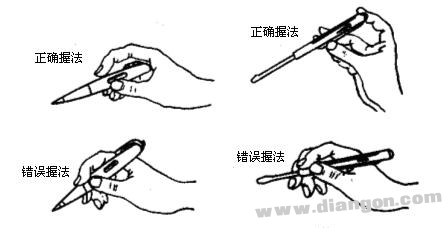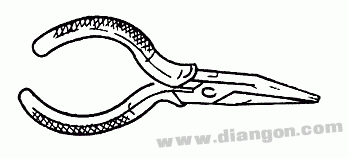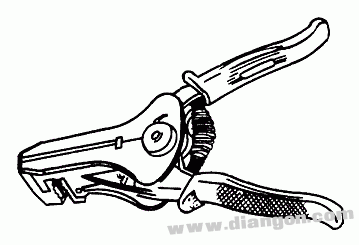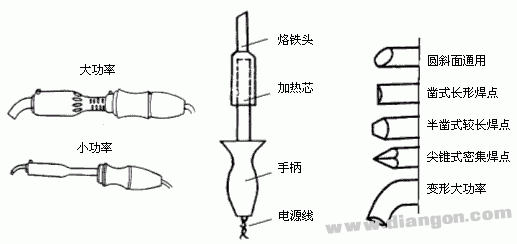1. When using the test pencil, the finger must touch the metal part of the end of the pen, and make the small window backlit and facing yourself, in order to observe the brightness of the fistula, to prevent misjudgment caused by too strong light. Figure 
When the charged body is tested with an electric pen, the current forms a current-carrying circuit through the charged body, the electric pen, the human body, and the earth. As long as the potential difference between the charged body and the ground exceeds 60 V, the manifold in the electric pen emits light. The voltage range of the low voltage electroscope is 60~500V.
Precautions:
l Before use, the electroscope must be tested at a power source to prove that the electroscope is in good condition before use.
l During the power inspection, the electroscope should be gradually approached to the object to be measured until the tube is bright and cannot directly touch the object.
l When checking the power, the finger must touch the metal body at the end of the pen. Otherwise, the charged body will be misidentified as a non-charged body.
When checking the power, prevent your fingers from touching the metal part of the pen tip to avoid electric shock. 2. Electrician knife 
When using an electrician knife:
l Do not use for live working to avoid electric shock.
l Cut the knife edge outward and take care to avoid hurting your fingers.
l When cutting the wire insulation layer, make the blade surface and the wire have a small acute angle to avoid cutting the wire.
After use, the blade will be folded into the handle 3. When the screwdriver is used,
l When the screwdriver is large, except for the thumb, forefinger and middle finger to grip the handle, the palm should also bear against the end of the handle to prevent slipping during the rotation.
l When the screwdriver is small, hold the handle with your thumb and middle finger, and use your index finger to force the end of the handle to rotate.
l When the screwdriver is long, press the handle with your right hand and turn it while holding the middle part of the screwdriver with your left hand (not around the screw to avoid scratching your hands) to prevent the screwdriver from slipping off.
Precautions
l When working on live, do not touch the metal rod of the screwdriver to avoid electric shock.
l As an electrician, you should not use a metal rod to straighten the screwdriver on top of the handle.
l In order to prevent the metal rod from touching the human body or adjacent electrified body, the metal rod should be covered with an insulating tube.
Fourth, wire cutters 
Wire cutters are used in a wide range of applications. The jaws can be used to bend or clamp the wire ends; the teeth can be used to tighten or loosen the nut; the knife edge can be used to cut the wire or clamp the wire insulation; the side port can be used to cut the wire core, wire and other hard Wire. The use of wire cutters for each purpose is shown in the figure above.
Precautions
l Before use, make the inspection wire cutters insulated, so as to avoid electric shock accidents during live working.
l When charging the wire, do not use the knife edge to simultaneously cut two wires of different potentials (such as phase line and neutral line, phase line and phase line, etc.) to avoid short circuit accidents.
5. Needle-nosed needle-nosed pliers are suitable for operation in a small working space due to the sharp tip of the head (as shown).
Needle-nose pliers can be used to cut smaller wires; they can be used to hold smaller screws, nuts, washers, wires, etc.; they can also be used to shape single-strand wires (such as straight, curved, etc.). If you use a needle-nose pliers for live working, check that the insulation is good and that the metal parts do not touch the human body or adjacent live parts during operation. 
6. The diagonal pliers are designed to cut off various wires and cables, as shown in the figure.
For materials with different thickness and hardness, diagonal pliers of appropriate size should be used. 
7. Stripping pliers Stripping pliers are tools designed to exploit the finer wire insulation. The shape is shown in the figure.
When stripping the wire insulation with a wire stripper, first set the insulation length to be stripped with a ruler, then place the wire into the corresponding edge (slightly larger than the wire diameter), and then hold the clamp handle by hand, the insulation of the wire That is, it is stripped. 
8. Before the soldering iron is soldered, the oxide layer of the soldering tip is generally removed, and the solder is used for the tin treatment, so that the front end of the soldering tip often maintains a thin layer of tin to prevent oxidation, reduce energy consumption, and conduct heat well.
There is no uniform requirement for the soldering iron's grip method. The principle is not easy to fatigue and easy to operate. Generally, there are two kinds of pen grip methods and fist grip methods, as shown in the figure.
Solder and flux must be used when soldering the wire with an electric soldering iron. The solder is generally silky solder or pure tin, and common agents are rosin, solder paste, and the like.
The basic requirements for welding are: the solder joint must be strong, the tin liquid must be fully penetrated, the surface of the solder joint is smooth and sleek, and "virtual welding" and "sand welding" should be prevented. The reason for the "virtary welding" is that the surface of the weldment is not cleaned or the flux is too small, so that the solder does not flow sufficiently, causing too little tin on the surface of the weldment, and the weldment is not sufficiently fixed; causing "sand welding" The reason is that the soldering iron does not melt sufficiently because the soldering iron temperature is low or the soldering iron residence time is too short during soldering. 
Electric iron soldering precautions
l Check whether the power cord is good and burned before use.
l When soldering electronic components (especially integrated blocks), safety measures such as leakage prevention should be used.
l When the welding head is not "eat tin" due to oxidation, do not burn hard.
l When the soldering head is more inconvenient to solder, do not rub tin; do not knock.
l When soldering smaller components, the time should not be too long to avoid damage to components or insulation due to heat.
After welding, the power plug should be removed and the soldering iron should be placed on the metal bracket to prevent burns or fire.
5.70mm Wire To Board Connectors
5.70mm Wire to Board,Wire To Board Connectors
5.70mm Wire to Board,Wire To Board Connectors
ShenZhen Antenk Electronics Co,Ltd , https://www.pcbsocket.com